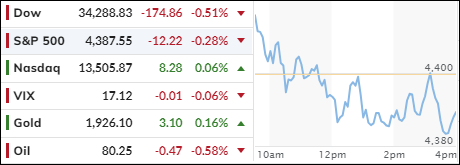
- Moving the markets
The stock market lost steam on Tuesday as a downgrade of several U.S. banks weighed on the financial sector and overshadowed the gains in tech stocks. S&P Global lowered its credit ratings and outlook for some regional and large banks, citing “tough” operating conditions.
The financial sector was the worst performer of the S&P 500, dropping 0.8%. Meanwhile, some retailers also dragged down the market, as Dick’s Sporting Goods and Macy’s plunged by 24% and 13%, respectively, after issuing cautious full-year guidance. The S&P Retail ETF followed suit, falling 1.2%.
On the bright side, tech giants Netflix and Alphabet rose, boosting the Nasdaq Composite. The bond market also remained in focus, as the 10-year Treasury yield eased slightly to 4.33% after hitting a 16-year high of 4.37% on Monday. The rising yield has been a source of concern for equity investors, as it signals higher borrowing costs and inflation expectations.
Some analysts warn that a breakout above the October highs in the 10-year yield could trigger a deeper pullback or even a breakdown in the stock market. Our Trend Tracking Indexes (section 3) are already pointing to a potentially bearish scenario.
Another sign of weakness in the market is the lack of short squeeze attempts, as the basket of the most shorted stocks has plummeted 21% from its July 31st peak. This is bad news for the bulls, but good news for the bears.
One stock that defied gravity was Nvidia, which soared to a record high in the pre-market before reversing course and ending lower. The chipmaker will report its earnings after the close on Wednesday, and investors will be eager to see if its results can justify its lofty valuation.
The currency and commodity markets were relatively quiet, with the dollar flat, gold slightly higher, and bond yields mixed. Rate hike expectations continued to rise, as the Fed is expected to tighten its policy in response to the inflationary pressures.
- “Buy” Cycle Suggestions
The current Buy cycle began on 12/1/2022, and I gave you some ETF tips based on my StatSheet back then. But if you joined me later, you might want to check out the latest StatSheet, which I update and post every Thursday at 6:30 pm PST.
You should also think about how much risk you can handle when picking your ETFs. If you are more cautious, you might want to go for the ones in the middle of the M-Index rankings. And if you don’t want to go all in, you can start with a 33% exposure and see how it goes.
We are in a crazy time, with the economy going downhill and some earnings taking a hit. That will eventually drag down stock prices too. So, in my advisor’s practice, we are looking for some value, growth and dividend ETFs that can weather the storm. And of course, gold is always a good friend.
Whatever you invest in, don’t forget to use a trailing sell stop of 8-12% to protect yourself from big losses.
- Trend Tracking Indexes (TTIs)
The markets were directionless again, with only the Nasdaq managing to post a small gain. Our Domestic TTI edged closer to breaking its trend line to the downside, signaling a possible bearish turn.
If that happens, we will first trim some of our positions and then sell everything if the markets continue to slide. The International TTI fared better, rising slightly, and showing more bullish momentum.
This is how we closed 08/22/2023:
Domestic TTI: +0.82% above its M/A (prior close +1.22%)—Buy signal effective 12/1/2022.
International TTI: +2.47% above its M/A (prior close +2.44%)—Buy signal effective 12/1/2022.
All linked charts above are courtesy of Bloomberg via ZeroHedge.
Contact Ulli